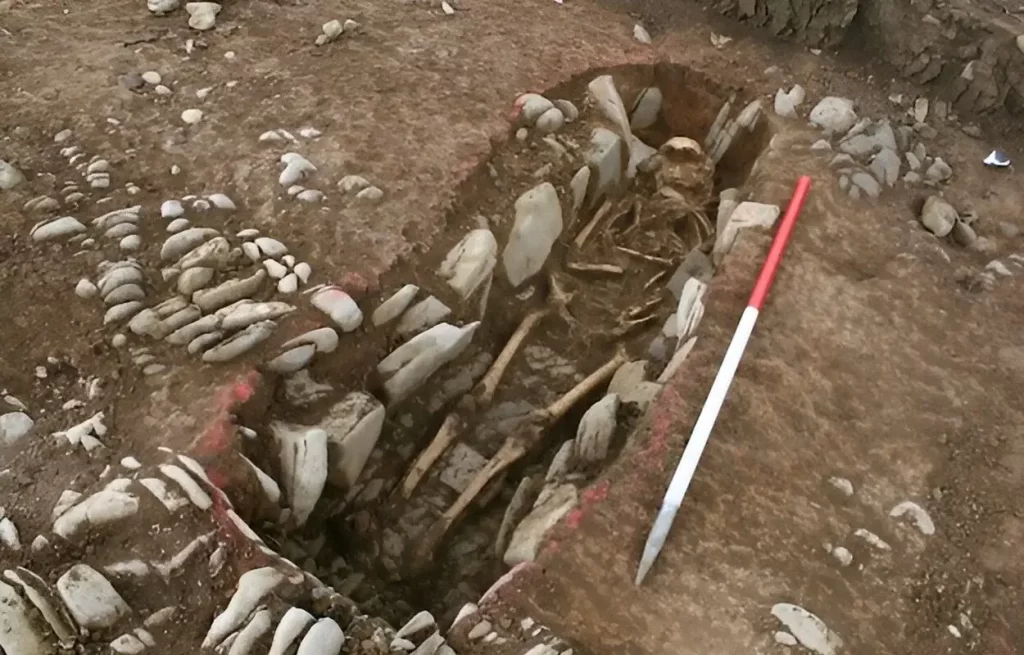Archaeologists conducting excavations at Fonmon Castle in South Wales have made an extraordinary discovery, uncovering compelling evidence of Medieval grave-side feasting rituals. These findings provide new insights into the cultural and burial practices of early inhabitants of the region, shedding light on a lesser-documented period of history.
Fonmon Castle, a historic stronghold in South Wales, was constructed around the year 1180. Despite its long-standing presence, much of the castle’s early history remains shrouded in mystery, with very few surviving records detailing its origins. Most of what is known today about its construction and historical significance has been pieced together through the meticulous study of its architectural features.

Historical accounts suggest that Oliver St John of Fonmon, one of the famed Twelve Knights of Glamorgan, was responsible for the castle’s construction during the Norman conquest of Glamorgan. These knights, under the command of Robert Fitzhamon, played a crucial role in securing Norman control over South Wales, establishing fortifications and exerting influence over the local Welsh population. However, physical evidence confirming the precise origins of Fonmon Castle has remained scarce, making recent archaeological excavations even more significant.
One of the most remarkable aspects of the excavation is the discovery of a cemetery within the castle grounds. This burial site has yielded a wealth of artifacts, including fragments of animal bone—some bearing clear evidence of butchery and cooking—alongside metalworking debris and pieces of rare imported glass drinking vessels. According to researchers, these materials are indicative of grave-side feasting rituals that took place approximately 1,400 years ago, a practice that adds a new layer of understanding to the customs of medieval societies in this region.
Dr. Andy Seaman, a Lecturer in Early Medieval Archaeology, expressed his enthusiasm about the discovery, emphasizing its rarity and importance. “This is a really exciting discovery. Sites of this date are extremely rare in Wales, and often do not preserve bone and artifacts to this extent. The Fonmon cemetery will allow us to discover so much about the people who lived here around 1,400 years ago.”
The excavation has revealed that the cemetery may contain up to 80 burials. Some of these burials display an unusual characteristic—bodies interred in a crouched position. This detail has intrigued archaeologists, as burial practices of this kind have been documented at other sites, yet the relatively high proportion of crouched burials at Fonmon Castle suggests a distinct funerary tradition. Dr. Seaman noted, “Other similar sites have found bodies in crouched positions such as this, but considering the number of graves we have looked at so far, there seems to be a high proportion. This could be evidence of some sort of burial rite being carried out.”
Further supporting the theory of ritual activity, Dr. Seaman pointed to the presence of cooking-related remains and imported glass drinking vessels. He explained, “There is nothing to suggest that people were living near the site, so the evidence of cooking and glasses certainly suggests some level of ritual feasting, perhaps to celebrate or mourn the dead.”
The concept of feasting at burial sites is not unprecedented in early medieval societies. Such practices were often performed as a means of honoring the deceased, strengthening community bonds, and facilitating the transition of the soul to the afterlife. These rituals could have been influenced by both pre-Christian and early Christian traditions, reflecting a blend of cultural and religious beliefs during this period.
The imported glass fragments found at the site are particularly noteworthy, as they suggest long-distance trade connections. During the early medieval period, high-quality glassware was a luxury item, typically reserved for the elite or used in significant ceremonial contexts. The presence of these rare glass vessels at Fonmon Castle indicates that those buried in the cemetery may have been of considerable status or that their funerary rites were conducted with great care and reverence.
Additionally, the presence of metalworking debris suggests that certain objects, perhaps tools, weapons, or ornamental items, were crafted or repaired at the site, possibly as part of the burial rites. It is not uncommon for grave goods to be deposited alongside the deceased, either as offerings or to equip them for the afterlife. However, the discovery of active metalworking within the cemetery itself is intriguing, raising questions about whether items were custom-made for specific burials or whether ritual smithing played a role in the ceremonies.
The discoveries at Fonmon Castle contribute to a broader understanding of burial customs in early medieval Britain, particularly in Wales, where documented archaeological sites from this period remain relatively scarce. This excavation offers a rare glimpse into how communities honored their dead, incorporating both feasting and distinct burial traditions.
As research continues, archaeologists hope to conduct further analyses of the human remains, animal bones, and artifacts to gain deeper insights into the individuals buried at the site. Isotopic and DNA analysis could reveal details about their diet, health, and even potential familial relationships among the deceased. By studying these remains, researchers aim to piece together a more comprehensive picture of the people who lived in this region over a millennium ago.
The findings at Fonmon Castle underscore the importance of archaeological exploration in uncovering hidden aspects of history. Every artifact, every bone fragment, and every burial site offers a key to understanding past societies—how they lived, how they mourned, and how they honored their dead. These discoveries remind us that history is not just written in books but is buried beneath our feet, waiting to be unearthed.
This remarkable excavation at Fonmon Castle has opened a new chapter in the study of early medieval Wales. As further research and analysis continue, the findings from this site are likely to contribute significantly to our understanding of burial customs, social structures, and cultural influences in medieval Britain. The evidence of grave-side feasting and ritual practices provides a fascinating look at the traditions of those who came before us, bridging the gap between the past and the present.





